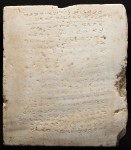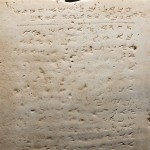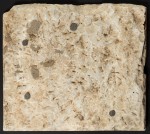 A marble tablet inscribed with the Ten Commandments in Samaritan will be sold at auction next month at at Heritage Auctions in Dallas. The Yavneh 10 Commandments Stone is roughly two-by-two feet, weighs 115 pounds and was carved probably between 4th and 8th centuries A.D. in the Samaritan variant of Paleo-Hebrew script. It is one of only five inscriptions of the Samaritan Decalogue from before the Muslim invasion known to survive.
A marble tablet inscribed with the Ten Commandments in Samaritan will be sold at auction next month at at Heritage Auctions in Dallas. The Yavneh 10 Commandments Stone is roughly two-by-two feet, weighs 115 pounds and was carved probably between 4th and 8th centuries A.D. in the Samaritan variant of Paleo-Hebrew script. It is one of only five inscriptions of the Samaritan Decalogue from before the Muslim invasion known to survive.
 A close derivative of ancient Phoenician, Paleo-Hebrew script was in use from at least as early as the 10th century B.C. — the Zayit Stone, the oldest inscription in the Paleo-Hebrew alphabet, dates to then — until the 5th century B.C. when Aramaic began to take its place. The Samaritans, however, continued to use their version of Paleo-Hebrew and still do so today.
A close derivative of ancient Phoenician, Paleo-Hebrew script was in use from at least as early as the 10th century B.C. — the Zayit Stone, the oldest inscription in the Paleo-Hebrew alphabet, dates to then — until the 5th century B.C. when Aramaic began to take its place. The Samaritans, however, continued to use their version of Paleo-Hebrew and still do so today.
Translated from the Samaritan dialect of Hebrew, the line-by-line inscription runs as follows:
1. Dedicated in the name of Korach
2. I will call you to remember for goodness forever
3. God spoke
4. all these words
5. saying I am the Lord
6. your God you shall not have
7. for yourself other Gods
8. besides me; you shall not make
9. for yourself a sculptured image or any likeness;
10. for I the Lord
11. your God am an impassioned God;
12. Remember the Sabbath day
13. keep it holy; honor
14. your father and your mother;
15. you shall not murder; you shall not commit adultery;
16. you shall not steal; you shall not bear [false witness] against your neighbor
17. you shall not covet; you shall erect
18. these stones that
19. I am commanding you today
20. on Mount Gerizim rise up to God
 You might notice they’re not quite the standard set of 10. The one about not taking the name of God in vain is missing, and there’s a new one at the end about building the temple on Mount Gerizim to house the tablets.
You might notice they’re not quite the standard set of 10. The one about not taking the name of God in vain is missing, and there’s a new one at the end about building the temple on Mount Gerizim to house the tablets.
The tablet’s origins are nebulous, but according to research done in the 1940s, it was discovered in 1913 by construction workers building a railroad near Yavneh on the southern coast of what was then Palestine. They either gave it or sold it to a wealthy local man who installed it on the floor of a doorway into his courtyard. Over time, the middle of the inscription was worn down be people walking on it, but it can still be read under oblique lighting.
 The son of the owner sold it in 1943 to Mr. Y. Kaplan who knew right away it was a rare Samaritan Decalogue tablet. Kaplan engaged scholar and expert in Samaritan history (and the future second President of Israel) Yitzhak Ben-Zvi to study the stone. It was he who determined its likely age range based on the writing style of the Samaritan. Later scholarship has expanded the possible date range to the early Islamic occupation period (ca. 640-830 A.D.), but the Byzantine date range is still prevalent.
The son of the owner sold it in 1943 to Mr. Y. Kaplan who knew right away it was a rare Samaritan Decalogue tablet. Kaplan engaged scholar and expert in Samaritan history (and the future second President of Israel) Yitzhak Ben-Zvi to study the stone. It was he who determined its likely age range based on the writing style of the Samaritan. Later scholarship has expanded the possible date range to the early Islamic occupation period (ca. 640-830 A.D.), but the Byzantine date range is still prevalent.
The stone was sold to an antiquities dealer in the 1990s and in 2005 was bought by Rabbi Saul Deutsch of the Living Torah Museum in Brooklyn, New York. As an object of Israeli cultural patrimony, the tablet’s export required a special permit from the Israel Antiquities Authority who allowed it on the condition that it was to be put on public display.
 The museum has a collection of ancient artifacts that illustrate people, places and things mentioned in the Torah, like 3,500-year-old Hittite toy chariots as examples of what the Egyptian chariots that chased the fleeing Jews during the Exodus may have looked like. Judging from what’s available online at least, some of the connections are tenuous at best. Fragments of Coptic-era Egyptian garments, for instance, are hardly indicative of what the Jews who left Egypt might have worn. While the tablet has been on display since the sale, as per the terms of the agreement with the IAA, it is not one of the artifacts included in the website’s slideshows.
The museum has a collection of ancient artifacts that illustrate people, places and things mentioned in the Torah, like 3,500-year-old Hittite toy chariots as examples of what the Egyptian chariots that chased the fleeing Jews during the Exodus may have looked like. Judging from what’s available online at least, some of the connections are tenuous at best. Fragments of Coptic-era Egyptian garments, for instance, are hardly indicative of what the Jews who left Egypt might have worn. While the tablet has been on display since the sale, as per the terms of the agreement with the IAA, it is not one of the artifacts included in the website’s slideshows.
The museum, which contains a large collection of artifacts of Jewish life and history dating back to antiquity, is shifting toward a more hands-on focus to attract younger visitors and decided it was time to sell the artifact.
“The sale will provide us with the money to do what we need to do. It’s all for the best,” Deutsch said in a statement.
The opening bid will be $250,000, a fortune for a small Brooklyn museum. One caveat, though, the condition requiring public display of the artifact still holds, so the buyer can’t just stash it in his cave of wonders. The auction is on November 16th, but you can bid online starting Friday, October 28th.
“As an object of Israeli cultural patrimony”: but didn’t the Jews treat the Samaritans as loathsome heretics?
Unfortunately they did. Not only as heretics but also as traitors. How any of them survived to this day and age is a miracle. Very few left, less than a thousand in their village on Mount Gezirim and a few small neighborshoods in Israel. Maybe someone will buy the tablet and return it to the community…….
O/T: for those who like rock art (and I do):
http://forwhattheywereweare.blogspot.co.uk/2016/10/armintxe-new-rock-art-site-discovered.html
“…who installed it on the floor of a doorway…” :ohnoes: I just broke out into hives.
It is most likely forged… There is no second commandment about “You are not to make use of the name of Shehmaa in vain”. But the biggest mistake is the name Korach: It is forbidden in Samaritan heritage.